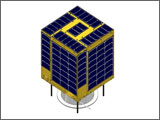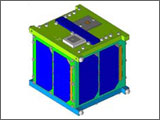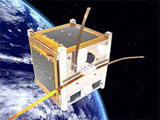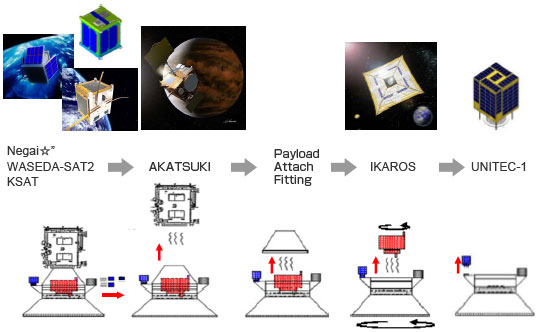- Deployment and extension of the large membrane
- Power generation by the thin film solar cells
- Verifying acceleration by the solar sail
- Acquiring navigation technology by the solar sail
* IKAROS (Interplanetary Kite-craft Accelerated by Radiation of the Sun)
Along with the main payload, AKATSUKI, five secondary payloads will be launched by an H-IIA Launch Vehicle. Launch opportunities are offered to secondary payloads that are manufactured by private companies and universities to contribute to enhancing education and fostering human resources. They are launched by utilizing the excessive launch capabilities of an H-IIA.
Introduction of the small secondary payloads
Small Solar Power Sail Demonstrator "IKAROS"* / Japan Aerospace Exploration Agency (JAXA)


UNITEC-1 / UniversitySpaceEngineeringConsortium (UNISEC)


- Competition to contend "whose computer for space use will survive the longest in deep space" among computers developed by universities for in-orbit verification
- Receiving, sending, and decoding technology experiments of faint radio waves from deep space in cooperation with amateur radio communities.
- Space outreach through the above experiments
- Science and engineering mission in deep space (option)
- Receiving, sending, and decoding technology experiments of faint radio waves from deep space in cooperation with amateur radio communities.
- Space outreach through the above experiments
- Science and engineering mission in deep space (option)
WASEDA-SAT2 / Waseda University


- QR code image shooting experiment
- Providing images to students
- Attitude stability by panel deployment
- Providing images to students
- Attitude stability by panel deployment
- Waseda Satellite Project (Japanese language only)
KSAT / Kagoshima University


- Observation experiments of atmospheric vapor distribution for predicting localized heavy rain
- Shooting moving images of the Earth through microwave high-speed communications
- Basic communication experiment for super-small positioning satellites
- Shooting moving images of the Earth through microwave high-speed communications
- Basic communication experiment for super-small positioning satellites
- K-SAT (Japanese language only)
Negai*″ / Soka University


- Wish upon a shooting star*″
- a satellite to support children's future
- Space verification of the advanced information processing system using commercial FPGA
- a satellite to support children's future
- Space verification of the advanced information processing system using commercial FPGA
- Negai*″ (Japanese language only)


